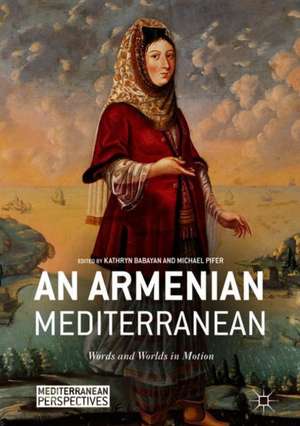An Armenian Mediterranean: Words and Worlds in Motion: Mediterranean Perspectives
Editat de Kathryn Babayan, Michael Piferen Limba Engleză Hardback – 24 mai 2018
| Toate formatele și edițiile | Preț | Express |
|---|---|---|
| Paperback (1) | 727.18 lei 43-57 zile | |
| Springer International Publishing – 9 feb 2019 | 727.18 lei 43-57 zile | |
| Hardback (1) | 737.57 lei 43-57 zile | |
| Springer International Publishing – 24 mai 2018 | 737.57 lei 43-57 zile |
Preț: 737.57 lei
Preț vechi: 899.48 lei
-18% Nou
Puncte Express: 1106
Preț estimativ în valută:
141.18€ • 153.40$ • 118.67£
141.18€ • 153.40$ • 118.67£
Carte tipărită la comandă
Livrare economică 21 aprilie-05 mai
Preluare comenzi: 021 569.72.76
Specificații
ISBN-13: 9783319728643
ISBN-10: 3319728644
Pagini: 243
Ilustrații: XXI, 337 p. 19 illus., 10 illus. in color.
Dimensiuni: 148 x 210 mm
Greutate: 0.73 kg
Ediția:1st ed. 2018
Editura: Springer International Publishing
Colecția Palgrave Macmillan
Seria Mediterranean Perspectives
Locul publicării:Cham, Switzerland
ISBN-10: 3319728644
Pagini: 243
Ilustrații: XXI, 337 p. 19 illus., 10 illus. in color.
Dimensiuni: 148 x 210 mm
Greutate: 0.73 kg
Ediția:1st ed. 2018
Editura: Springer International Publishing
Colecția Palgrave Macmillan
Seria Mediterranean Perspectives
Locul publicării:Cham, Switzerland
Cuprins
1. Introduction: A Moveable Armenia.- I. Rethinking Boundaries.- 2. The Age of the Gharīb: Strangers in the Medieval Mediterranean.- 3. Past the Mediterranean and Iran: A Comparative Study of Armenia as an Islamic Frontier, 1st/7th–5th/11th Centuries.- 4. A Fish out of Water? Medieval Armenia(ns) and the Mediterranean.- II. Connecting Histories.- 5. From "Autonomous" to "Interactive" Histories: World History's Challenge to Armenian Studies.- 6. Mapping Jerusalem: Re-Reading the City in the Context of the Medieval Mediterranean.- III. Breaking National and Imperial Paradigms.- 7. Between Anatolia and the Balkans: Tracing Armenians in the Post-Ottoman Order.- 8. Armeno-Turkish Writing and the Question of Hybridity.- 9. Wandering Minstrels, Moving Novels: The Case of Khach'atur Abovyan's Wounds of Armenia.- IV. Texturizing Diaspora.- 10. Weaving Images: Textile, Displacement, and Reframing the Borders of Visual Culture.- 11. Diasporic Flânerie: From Armenian Ruinenlust to Armenia's Walkscapes.- 12. Spaces of Difference, Spaces of Belonging: Negotiating Armenianness in Lebanon and France.- V. Placing Statehood.- 13. Contemporary Armenian Drama and World Literature.- 14. How to Write the History of the Third Republic (or How Not to Write It).- VI. Epilogue.- 15. The Mediterranean is Armenian.
Notă biografică
Kathryn Babayan is Associate Professor of Iranian History and Culture and Director of the Armenian Studies Program at the University of Michigan, USA.
Michael Pifer is Lecturer in Armenian Language and Literature at the University of Michigan, USA.
Textul de pe ultima copertă
This book rethinks the Armenian people as significant actors in the context of Mediterranean and global history. Spanning a millennium of cross-cultural interaction and exchange across the Mediterranean world, essays move between connected histories, frontier studies, comparative literature, and discussions of trauma, memory, diaspora, and visual culture. Contributors dismantle narrow, national ways of understanding Armenian literature; propose new frameworks for mapping the post-Ottoman Mediterranean world; and navigate the challenges of writing national history in a globalized age. A century after the Armenian genocide, this book reimagines the borders of the “Armenian,” pointing to a fresh vision for the field of Armenian studies that is omnivorously comparative, deeply interconnected, and rich with possibility.
Caracteristici
Offers fresh perspectives on the study of Armenian history, literature, and visual culture Appeals to scholars of comparative literature, global history, Mediterranean studies, Armenian studies, and medieval history Draws from and contributes to a wide array of comparative and theoretical frameworks, including world history, world literature, and Mediterranean studies











